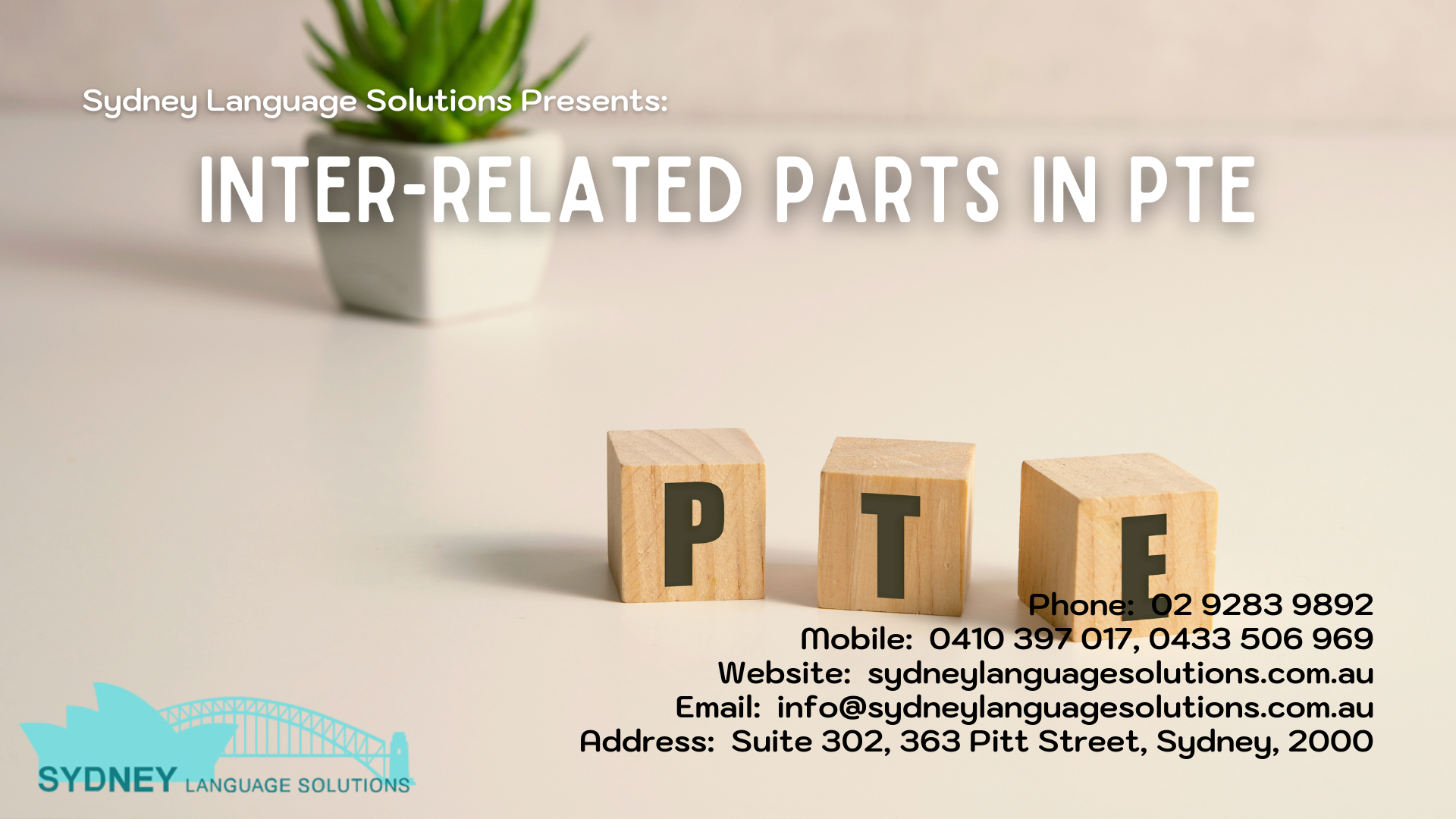INTER-RELATED PARTS IN PTE

Different from IELTS, PTE is structured with some parts assessing more than one skill. For example, Read Aloud is not only used to test your Speaking but also Reading skills.
- PTE PARTS THAT AFFECT MORE THAN ONE SKILL ARE:
1.Speaking: Read Aloud; Repeat Sentence; Retell Lecture
2.Writing: summarize Written Text
3.Reading: Fill in Blanks (Drop-down box)
4.Listening: summarize Spoken Text; Write from Dictation; Fill in Blanks
- BELOW IS FURTHER EXPLANATION FOR SOME OF THE “MORE THAN ONE SKILL ASSESSMENT ” PARTS IN PTE:
1.Read Aloud (RA): The RA section affects speaking and reading test scores. It is a simple task but contributes a lot of points to your results. To do this part well, you need to pay attention to 3 elements Fluency, Pronunciation and Content. If Fluency and Pronunciations are used to assess your speaking ability, Content is a factor for scoring reading skills.
2. Repeat Sentence (RS): The RS scores will be distributed to Speaking and Reading. This part requires the candidates to listen to the sentence repeat within 3 seconds after the “beep” sound. It would be essential to sharpen your listening skill by practicing from PTE question banks or listening to news on BBC, 9News… Moreover, you need to enhance your memory by trying to memorizing and repeating sentences in a short time.
3. Fill in the Blanks (FIB): There are three FIB parts the PTE test: FIB Listening, FIB Reading and FIB Reading and Writing. These parts are important because they affect more than one skill and contains numerous points. Each section usually has 4-5 sentences and each sentence has 4-5 points. To do these parts well, you need to pay attention to grammar and practice vocabulary.
4. Write From Dictation (WFD): Like the RS section, you will be assessed for listening but instead of checking the speaking part, you also must show the ability to write properly. You will be evaluated the Content (each correct word in both order and spelling will get 1 point).
By knowing this, you can optimize your time in practicing key parts for the best results. Surely with companions of SLS, you will gain more confidence to win PTE.
Tips on How to Achieve a High PTE Mark
TIPS ON HOW TO ACHIEVE A HIGH PTE MARK:
- Fluency is your main priority in speaking module. Avoid taking long pauses while responding to the question. Mistakes in pronunciations here and there are acceptable, the exam just wants to make sure you can communicate your ideas clearly.
- Work on your spelling: It is really important that you know how to spell your words correctly. Go through past exam questions and make sure you know how to spell all the words right from dictation and fill in the blanks questions.
- Have a good understanding of English grammar: the PTE exam aims to test your understanding of basic grammar. The main areas to focus on would be using appropriate tenses, understanding passive voice and active voice, understanding subject and verb agreement.
- Practice for your speaking test in a noisy environment: this will help you to gain knowledge of how many of your words the machine can pickup even in a noisy environment and will help you speak more clearly and confidently.
- Time management in the writing section: don’t spend all your time writing your article/essay. It is essential to manage your time in such a way that you have time to review and proof-read your work before submitting.
5 Tips on How to Reduce Your Accent to Sound Like a Native Speaker
Having an accent is not a bad thing; one should not be ashamed of it. A person’s accent represents his or her background and culture. Lots of people take pride in their accent as it reveals their cultural heritage. Even English native speakers have their own accents such as American-English, British-English or Australian-English. However, this sometimes causes difficulty in understanding so some people are embarrassed by their own accent in English Speaking. It turns out that having a residual accent might affect self-confidence in communication and interaction.
There are some techniques that non-native English speakers can use to reduce their accent in speaking.
- Slow down and clearly pronounce words
People tend to speak fast when they are excited or nervous. If you have an accent, try to speak slowly and clearly pronounce words so that everyone can understand what you want to say.
- Feel the rhythm while speaking English
English is considered “stressed language” as every single word have its own stress, differently on verbs, words and adjectives. Same to sentence. People said that sentence stress gives English a rhythm or beat.
- Listen and Talk to native speakers
Listen and repeat to sentences spoken by native speakers until you can naturally speak those sentences. Try to speak to the native speakers as many as possible. You need to overcome your in-confidence and speak to the native speakers. It might make you feel embarrassed at first but failure creates success. People also tend to imitate others whom they frequently interact with. Therefore, the more you talk to the native speakers, the more you could improve.
- Record yourself
Don’t learn from others only, learn from yourself. Take your time to record your speaking and listen again to identify your weaknesses. Recording will also make you proud of yourself in how clarity in your pronunciation has progressed.
- Take a class or tutor
Consider working with an experienced tutor or teacher to help you with pronunciation, intonation and even vocabulary. An ESL teacher will have his/her strategy to quickly help you with your accent. Joining a class might also motivate you as you have partners in your accent reduction journey.
English Pronunciation: Compound Adjectives
A compound adjective is a fixed expression which is made up of more than one word and which has the function of an adjective. Most compound adjectives are written with a hyphen, but a few are written as one word:
skin-deep long-term threadbare
The following types of compound adjective usually have main stress on the first part:
- compound adjectives usually written as one word
- ‘ airtight ‘ carefree ‘ praise , worthy
- Exceptions: , nation ‘ wide, , hand ‘ made
- noun + -ing form
- ‘ hair- , raising ‘ fee- , paying ‘ time-con,suming
- noun + past participle
- ‘ poverty- , stricken ‘ pear-shaped ‘ health-re,lated
- Exceptions: , eagle- ‘ eyed, , home- ‘ grown
The following types of compound adjective usually have main stress on the second part:
- noun + adjective
- , fat- ‘ free , sky- ‘ high , snow- ‘ white
- Exception: ‘ camera-shy
- adjective + noun
- , long – ‘ term , full – ‘ length , high – ‘ profile
- adverb or adjective + past participle
- , fully- ‘ grown , long- ‘ sighted , well – ‘ dressed
- adverb or adjective + -ing form
- , easy- ‘ going , hard – ‘ working , well – ‘ meaning
- Exceptions: ‘ backward – , look ing, ‘ forward- , looking
- self- as the first part
- , self- ‘ confident , self-in ‘ flicted , self- ‘ governing
Most compound adjectives with main stress on the second part can have stress shift. Compare:
- The tiger was fully-GROWN. but: It was a FULly-grown TIger.
- The prices were sky-HIGH. but: They were SKY-high PRIces.
5 Reasons Why Good English is Essential in Business!
English is the language of communication: English is the most widely spoken language in the world with over 1 billion people using it as a foreign language.
English spoken in business is different from English spoken in daily lives, as certain industries have certain vocabulary or jargon. For example, English vocabulary is different in business administration, finance, law or retail.
Mastery of English is beneficial even though you are working in your home country. Many businesses are international in scope and English is official language in the company.
Better job opportunities: if you work in English-speaking countries, English is a must. In non-English-speaking countries, it would be another skill that you can add to your resume and would boost your chances of job promotion.
More confidence in working: Business English with Sydney Language Solutions will improve your confidence in presentation, negotiation, conversation, better comprehension and pronunciation in Business context. All of these will boost your confidence in conducting Business in English.
PTE Speaking- Read Aloud
PTE Speaking: Read Aloud
What is ‘Read Aloud’?
- Read Aloud is the first speaking Item type in the PTE Speaking section. There are usually 6-7 questions for Read Aloud and it credits you score for both Speaking and Reading.
- Read Aloud requires you to demonstrate your ability to read fluently and pronounce correctly a passage provided on the screen.
- Read Aloud tests you on your ability to identify a writer’s purpose, style, tone or attitude; understand academic vocabulary and read a text under timed conditions (PTE Score Guide, v.11, 2019)
What do I do?
- You will have 40 seconds to prepare before the microphone opens.
- You will have 40 seconds to read the passage out loud to the microphone.
Scoring Criteria
- Read Aloud is scored based on three Criteria – (1) Oral Fluency – (2) Pronunciation – (3) Content.
- Among the three criteria, Oral Fluency is the most important while Content is the least important. This means that you can score high in Speaking with good Oral Fluency and bad Content; but you can NOT score high in Speaking with bad Oral Fluency and good Content.
- Remember, it’s all about Oral Fluency. The more fluent you are, the higher score in Speaking you can achieve.
Common Mistakes
- We all like to have everything perfect and so is doing Read Aloud. We all want to read all the words out loud and pronounce them all correctly. Therefore, we never mind repeating ourselves a million times or hesitating in pronouncing a word for perfect pronunciation. Why not? It’s all for perfection! The more perfect we are, the better score we get. However, this seems to be a misconception that we know but find it hard to find back our human instinct in perfecting what you do.
- The brutal fact is if you miss or mispronounce a few words in the passage, it’s not the end of the world. However, repeating yourself to make sure you read all of the words in the passage guarantees you a ticket to the PTE website to re-book for another PTE test. So choose wisely!
- What’s else? The punctuation! We were all taught at primary school that we pause at commas and rest for our breath at full stops. We were all taught that reading slowly and musically enhances the effects of our speech. We were all taught that leaving some extended pauses may leave the audience some room to think. So we apply these beautiful taught habits into PTE, and wait with a fantasy that the highly anticipated magic number ‘90’ will appear on our Score Report; and sadly, fall down to earth from cloud nine knowing that the magic number has been printed the other way around. So think wisely!
Tips
To do Read Aloud well, you can consider these steps
- Prepare yourself in the 40 seconds wait. Read SILENTLY to yourself so you can prepare for the pronunciation of difficult words.
- What if you don’t know the pronunciation. Easy, just say whatever you think is right!
- Put your finger on the screen. Trace the finger along when you read. This helps with concentration.
- Speak fluently and fast, but allow you a quick pause at full stops so you can catch your breath.
PTE Listening – Write From Dictation
Question type #20 PTE Listening & Writing: Write from Dictation
Familiarise with how the question is formed
– There are 3-4 sentences, each of which has up to around 12 words.
– You have 5 seconds to mentally prepare yourself before the sentence is read to you.
– You need to type the sentence exactly as you hear it into the dialog box on the screen.
Understand how this question is scored
– Each correct word (for each sentence), spelled correctly and in the correct order will earn 1 small mark
– No extra penalty for wrong answer.
– Maximum mark:9-12; minimum mark: 0
Avoid these common mistakes
- Write down the sentence and transfer later. Instead, type in directly as soon as you hear it as you may not have enough time to do this, since this is the last question type in the listening section.
- Type all words in capital letters. Only do this for the first letter if it is a proper name or it is the first word in the sentence.
- Miss the plural form of a noun when it is a count noun.
- Miss the –s/es for a verb when you have a singular subject.
- Use the wrong word form. (e.g., a noun when you need an adjective, a verb or an adverb).
- Swap the word order or try to paraphrase a word. Remember, you’ll only earn marks if the words are spelled correctly and also are in the correct sequence as it is read by the speaker.
Practise the best way to do it
- Picture the sentence structure and sentence meaning in your mind before you start typing. Take mental note of the ‘story’, S-V agreement, and the position of time expression, adverb of places and linking word used.
- Type in the sentence as accurately as possible.
- Proofread quickly to make sure the spelling, grammar and the word forms are correct.
- You should spend around 30 seconds doing this, time permitting.
Listening – Select Missing Word
Question type #18 PTE Listening: Select missing word
Familiarise with how the question is formed
– There are 2-3 questions, each of which refers to a brief lecture of 40-90 seconds.
– The Topic will be on the screen in the instruction part.
– You have 7 seconds to preview the topic and the 4-5 options before the lecture starts.
– The lecture will be cut off when the time gauge reaches the end in the middle of the screen, when you hear a beep.
– You need to choose 1 best response which logically finishes the lecture.
Understand how this question is scored
– Each correct response will earn 1 mark
– No extra penalty for wrong answer.
– Maximum mark: 1; minimum mark: 0
Avoid these common mistakes
- Not reading the TOPIC. Doing this will help you tune in to the lecture.
- Get carried away while listening. Taking down some key words pertaining to the topic and main points should help you to concentrate.
- Choosing the option with the exact word(s) which you hear in the lecture. In fact, this is the obvious wrong answer!
- Rushing when choosing options. Remember, it’s good practice to spend up to 20 seconds on this question type after the lecture.
Practise the best way to do it
- Skim read the topic and the options to help you focus on the topic.
- Take brief notes while listening. Ask yourself what the topic is and what the main points are.
- As you take notes, notice the use of linking words (e.g., however, because, therefore, but, in conclusion, etc).
- Concentrate on the linking word and content when the lecture is nearing the end.
- After the lecture is cut off (the beep), take around 20 seconds to systematically eliminate answer choices which are opposite in tone.
- Let’s say the tone of the lecture is favourable, but you hear ‘However’ towards the end, so you need to find a word/phrase with a negative sense. Also, note whether you have to choose a strong or weak word.
Tips on PTE Describe Image Section
What is ‘Describe Image’?
- Describe Image is the third speaking Item type in the PTE Speaking section. There are usually 6-7 questions for Describe Image that may come with pictures or videos for illustrations. Describe Image only credits you score for Speaking.
- Describe Image requires you to demonstrate your ability to describe what you see in the image provided. Please remember that your only job is to Describe, so you are not to Explain any features, nor are you to Interpret any hidden messages. You only Describe the literal meaning and items that you see in the image.
What do I do?
- You will have 25 seconds to look at the picture and decide what to say.
- You will have 40 seconds to describe the image to the microphone.
Scoring Criteria
- Describe Image is scored based on three Criteria – (1) Oral Fluency – (2) Pronunciation – (3) Content.
- Among the three criteria, Oral Fluency is the most important while Content is the least important. This means that you can score high in Speaking with good Oral Fluency and bad Content, but you can NOT score high in Speaking with bad Oral Fluency and good Content.
- Remember, it’s all about Oral Fluency. The more fluent you are, the higher score in Speaking you can achieve.
Common Mistakes
- We all like to interpret and explain because it shows higher order thinking and the ability to analyse and evaluate. Also, this makes our answer look more sophisticated and advanced. Will this bring extra marks? The answer is NO.
- The reason being is when you interpret, the information you say is not included in the transcript which the computer bases upon to mark your work. As a result, your Content mark will below.
- Moreover, interpreting and explaining require thinking, and once you think, you will not be fluent. Hence, this combination drags both your Content and Oral Fluency marks down.
Tips
To do Describe Image well, you can consider these steps
- Have a generic opening phrase ‘The picture in front of me gives information about…’
- Read the Title and the Legend/ Note
- Have a direction for yourself – From Left to Right/ From Top to Bottom
- Only use words that you are 100% confident with their Pronunciation
- Minimise Thinking → Keep it Simple and Easy
Tips for PTE Read Aloud section
What is ‘Read Aloud’?
- Read Aloud is the first speaking Item type in the PTE Speaking section. There are usually 6-7 questions for Read Aloud and it credits you score for both Speaking and Reading.
- Read Aloud requires you to demonstrate your ability to read fluently and pronounce correctly a passage provided on the screen.
- Read Aloud tests you on your ability to identify a writer’s purpose, style, tone or attitude; understand academic vocabulary and read a text under timed conditions (PTE Score Guide, v.11, 2019)
What do I do?
- You will have 40 seconds to prepare before the microphone opens.
- You will have 40 seconds to read the passage out loud to the microphone.
Scoring Criteria
- Read Aloud is scored based on three Criteria – (1) Oral Fluency – (2) Pronunciation – (3) Content.
- Among the three criteria, Oral Fluency is the most important while Content is the least important. This means that you can score high in Speaking with good Oral Fluency and bad Content, but you can NOT score high in Speaking with bad Oral Fluency and good Content.
- Remember, it’s all about Oral Fluency. The more fluent you are, the higher score in Speaking you can achieve.
Common Mistakes
- We all like to have everything perfect and so is doing Read Aloud. We all want to read all the words out loud and pronounce them all correctly. Therefore, we never mind repeating ourselves a million times or hesitating in pronouncing a word for perfect pronunciation. Why not? It’s all for perfection! The more perfect we are, the better score we get. However, this seems to be a misconception that we know but find it hard to find back our human instinct in perfecting what you do.
- The brutal fact is if you miss or mispronounce a few words in the passage, it’s not the end of the world. However, repeating yourself to make sure you read all of the words in the passage guarantees you a ticket to the PTE website to re-book for another PTE test. So choose wisely!
- What’s else? The punctuation! We were all taught at primary school that we pause at commas and rest for our breath at full stops. We were all taught that reading slowly and musically enhances the effects of our speech. We were all taught that leaving some extended pauses may leave the audience some room to think. So we apply these beautifully taught habits into PTE, and wait with a fantasy that the highly anticipated magic number ‘90’ will appear on our Score Report; and sadly, fall down to earth from cloud nine knowing that the magic number has been printed the other way around. So think wisely!
Tips
To do Read Aloud well, you can consider these steps
- Prepare yourself in the 40 seconds wait. Read SILENTLY to yourself so you can prepare for the pronunciation of difficult words.
- What if you don’t know the pronunciation. Easy, just say whatever you think is right!
- Put your finger on the screen. Trace the finger along when you read. This helps with concentration.
- Speak fluently and fast, but allow you a quick pause at full stops so you can catch your breath.







Latest Comments